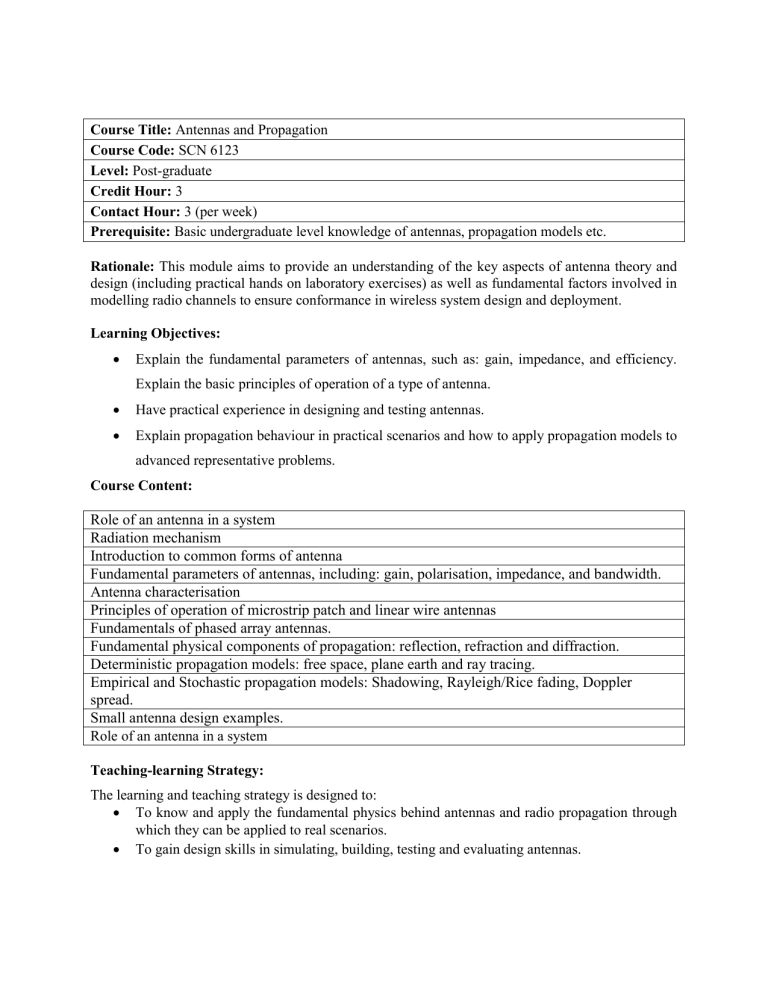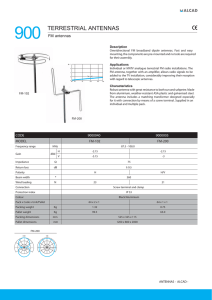
Course Title: Antennas and Propagation Course Code: SCN 6123 Level: Post-graduate Credit Hour: 3 Contact Hour: 3 (per week) Prerequisite: Basic undergraduate level knowledge of antennas, propagation models etc. Rationale: This module aims to provide an understanding of the key aspects of antenna theory and design (including practical hands on laboratory exercises) as well as fundamental factors involved in modelling radio channels to ensure conformance in wireless system design and deployment. Learning Objectives: Explain the fundamental parameters of antennas, such as: gain, impedance, and efficiency. Explain the basic principles of operation of a type of antenna. Have practical experience in designing and testing antennas. Explain propagation behaviour in practical scenarios and how to apply propagation models to advanced representative problems. Course Content: Role of an antenna in a system Radiation mechanism Introduction to common forms of antenna Fundamental parameters of antennas, including: gain, polarisation, impedance, and bandwidth. Antenna characterisation Principles of operation of microstrip patch and linear wire antennas Fundamentals of phased array antennas. Fundamental physical components of propagation: reflection, refraction and diffraction. Deterministic propagation models: free space, plane earth and ray tracing. Empirical and Stochastic propagation models: Shadowing, Rayleigh/Rice fading, Doppler spread. Small antenna design examples. Role of an antenna in a system Teaching-learning Strategy: The learning and teaching strategy is designed to: To know and apply the fundamental physics behind antennas and radio propagation through which they can be applied to real scenarios. To gain design skills in simulating, building, testing and evaluating antennas. To explain the difference as well as advantages and disadvantages of different propagation models and know the contexts in which they can be used for fixed and mobile link deployments. Learning and teaching methods include the following: Lectures up to three hours per week in a single block (including short breaks in between). Where lectures are less than three hours, the remaining time is given to tutorial time. Two weeks of thee hour laboratory classes, one week with a computer aided design (CAD) based assignment and the other as a practical lab building and testing an antenna prototype. Assessment Strategy: Class tests, Assignments, Seminar/Presentation and Final exam. The assessment strategy for this module is designed to provide students with the opportunity to demonstrate not only knowledge in antenna theory but to apply the theory through the laboratory exercises they will undertake whereby they will realise the challenges in designing an antenna both in the context of simulating a design but also in building a prototype. Students will also gain a hands on experience in measuring and evaluating antenna prototype designs. The examination will test not only knowledge of antenna theory and principles of radio propagation but to apply such cases to problem solving suited to the deployment of fixed and mobile wireless links. Thus, the summative assessment for this module consists of the following. A two hour written exam consisting of four questions, where a choice of three questions should be attempted. Each question contains a problem solving task. This constitutes 80% of the final mark. A practical lab task designing and testing a prototype antenna (3 hours), after which a laboratory report is submitted two weeks after the week of the laboratory, usually weeks 6 or 7 depending on when the laboratory took place. This constitutes 10% of the final mark. A computer aided design (CAD) laboratory (3 hours) using Computer Simulation Technology (CST) Microwave Studio. The laboratory will include familiarisation with the package after which an antenna is to be designed. The results of the design are submitted at the end of the laboratory. This constitutes 10% of the final mark. Any deadline given here is indicative. For confirmation of exact dates and times, please check the Departmental assessment calendar issued to you. Formative assessment and feedback For the module, students will receive formative assessment/feedback in the following ways. During lectures where suitable problem tests are included within the sessions During tutorials/tutorial classes During supervised laboratory sessions During supervised computer laboratory sessions Reference Books: 1. Antennas and propagation for wireless communication systems by Saunders, Simon R.; Aragón-Zavala, Alejandro, 2007. 2. Antenna theory: analysis and design by Balanis, Constantine A., 2005. 3. Antennas for all applications by Kraus, John Daniel; Marhefka, Ronald J., 2003. 4. The mobile radio propagation channel by Parsons, J. D., 2000. 5. Propagation of radiowaves by Hall, M. P. M.; Barclay, L. W.; Hewitt, M. T.; Institution of Electrical Engineers, 1996. Course Title: RF Systems and Circuit Design Course Code: SCN 6125 Level: Post-graduate Credit Hour: 3 Contact Hour: 3 (per week) Prerequisite: Basic undergraduate level knowledge of RF system, Microwave integrated circuits etc. Rationale: This module aims to provide an understanding of active microwave circuit and systems design. This module will also cover the key elements of RF and microwave system design as well as analysis concepts for a range of commonly used active circuits, including: oscillators, frequency synthesisers, amplifiers and mixers. The module will also cover the circuit design and operation of non-linear devices used in active circuits together with deployment considerations. Learning Objectives: Demonstrate knowledge of how to apply RF systems and circuit design concepts in existing and future radio technologies, including use of S-parameters and the decibel scale. Be able to design and analyse circuits containing active non-linear components most commonly used in active RF devices. Understand how to use and apply data measured with RF test and measurement equipment including network analysers and spectrum analysers. Recognise commonly used active RF devices and know how to integrate them into systems. Apply circuit design theory within a computer simulation environment. Course Content: Revision of prerequisite background material, including: S-parameters, decibel scale, transmission line theory, smith charts. Functionality and structure of RF non-linear circuit components, including: diodes, and field effect transistors. RF power amplifier performance, analysis, and design, including: amplifier classes, amplifier stability, non-linearity, intermodulation distortion, adjacent channel interference. Oscillator circuit design and operation, including: feedback loops, frequency synthesis, phase noise. Single balanced and double balanced active and passive mixer circuit design. Role of mixers in RF systems, including up conversion, down conversion. RF system considerations, including: dynamic range, link budget analysis, and noise figure calculations. Microwave integrated circuits; role, applications, and technology overview. RF test and measurement, including: spectrum analysers and network analysers. Computer aided RF circuit design laboratories. Teaching-learning Strategy: The learning and teaching strategy is designed to: To build on and extend knowledge of measurement parameters used in radio frequency (RF) electronics including scattering parameters, link budgets, the decibel scale and amplifier characteristics. To apply knowledge of the measurement parameters to RF systems and circuit design. To gain competence in RF simulation and test and measurement. Learning and teaching methods include the following: Lectures 3 hours per week x 8 weeks. Tutorials 3 hours per week x 2 weeks. Computer based laboratory sessions 3 hours per week x 3 weeks. The computer based laboratory sessions will provide an opportunity for the students to learn how to use computer aided design (CAD) software. The fourth laboratory session will incorporate a 2 hour test which will constitute the coursework element of this module. Assessment Strategy: Class tests, Assignments, Seminar/Presentation and Final exam. The assessment strategy for this module is designed to provide students with the opportunity to demonstrate their competence in using fundamentals of RF electronics and applying them to real life problem solving scenarios. This is achieved in part through a computer aided design laboratory (CAD) assessment which the student is required to document in a professional manner. Thus, the summative assessment for this module consists of: A computer aided design (CAD) laboratory assessment, which follows three weeks of preparation in supervised laboratory sessions. This is weighted to 20% of the final mark. Closed book written examination, 2 hours in which students have a choice of three questions out of four available questions. This is weighted to 80% of the final mark. Formative assessment and feedback For the module, students will receive formative assessment/feedback in the following ways. During lectures, by question and answer sessions. During lectures, by peer instruction (subject to a large enough class size). During tutorials/tutorial classes. During supervised computer laboratory sessions. Via assessed coursework. Reference Books: 1. Microwave active circuit analysis and design by Clive Poole; Izzat Darwazeh, 2016. 2. Microwave engineering by Pozar, David M., 2012. 3. Antennas for all applications by Kraus, John Daniel; Marhefka, Ronald J., 2003. 4. RF Circuit Design by Richard Chi-Hsi Li., 2012. 5. RF circuit design by Chris Bowick; John Blyler; Cheryl Ajluni, 2008.

